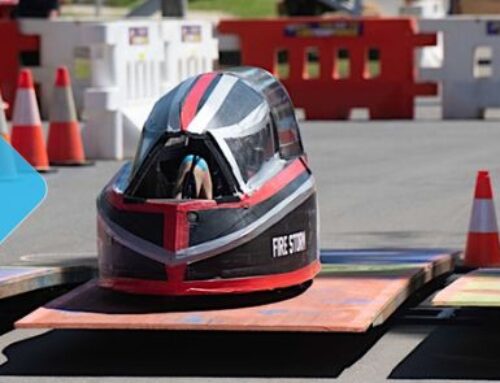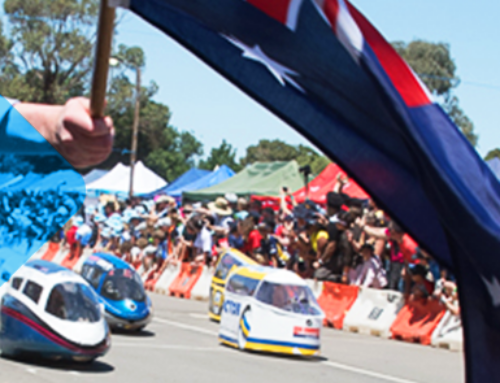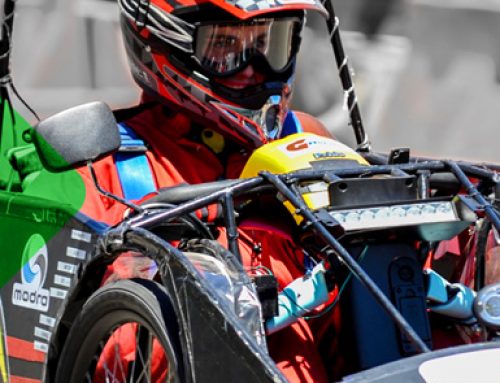New year, new rules! After publishing a set of draft rule changes under consideration last year, our Lead Scrutineers Michael McTigue and Tim White have gathered feedback, deliberated, discussed and now finalised the 2019 Energy Breakthrough Vehicle Specifications and Trial Regulations for HPV, EEV and TRYathlon teams.
What’s the background to these rules?
After the 2018 event, a consultation session was held in Bendigo and via videoconference with interested HPV and EEV people to discuss and explore key rule changes for 2019.
Furthermore, many schools and Team Managers will be aware that other Human Powered Vehicle (HPV) events follow a different rule book to ours. Mick, Tim and the EB team have worked hard to ensure that our guiding principles and aims are met through these rules, whilst eliminating unnecessary pain points for schools who are planning to compete in many events in many locations this year.
Here are some of the guiding principles of developing rules for the Energy Breakthrough:
We are education-focused in our approach.
It’s not just a ‘race’ to us. We understand that young people and teachers won’t always get things right at the start of the event, but we hope that by the end of the event everyone has learnt and improved.
We are schools-focused.
We try to use language that teachers and students will understand and can discuss together.
We encourage Innovation in vehicle design
Which is why we are happy to consider rear-wheel steer designs again and have introduced the McCulloch’s Engineering School Based Build Prize.
We seek to emphasise safety …
… in vehicle design, track design, race management and rider treatment.

Key Vehicle Specification Changes for 2019
Section 3: Dimensions and Turning Circle
- Teams can now attempt to build four-wheeled vehicles that may be narrower than three-wheeled vehicles.
- It is recommended that vehicles entered in the HPV Primary, HPV Secondary and EEV categories have a 12 metre turning circle.
Section 5: Access for Enclosed Bodywork Vehicles
- The Energy Breakthrough will now be providing stickers in a sticker kit at Check-In to help anyone unfamiliar with the vehicle clearly identify the closure devices on opening body sections.
Section 6: Rider Protection
- There have been some significant changes in this area, in particular, fully enclosed hard shell vehicles are required to have a piece of Ethylene Vinyl Acetate (EVA) foam placed above the rider’s head. We encourage all Team Managers to review this section carefully to ensure their vehicles are prepared well.
- There were a large number of vehicles at last year’s event which did not have adequate shielding around their front wheels. We’ve added some new advice and an image to help teams prepare around this.
Section 10: Steering
- After a number of years on the sidelines, we are willing to consider Rear Wheel Steer vehicles as we believe they provide a good avenue for innovation in vehicle design. This is on the provision that a submission is made to the Scrutineering team and adequate prototyping is carried out prior to the event.
Section 11: Brakes
- Teams may now set up their front brakes to operate ‘Independently’ from one another. (ie/ Left hand lever for left hand brake; Right hand lever for right hand brake). Team Managers are encouraged to provide additional training opportunities for riders prior to the event for vehicles with “Independent” braking systems.
Section 12: Lighting
- There is now no longer a minimum height for the headlight.
Section 17: Transponders
- A number of teams experienced transponder issues last year related to ‘noise’ and ‘interference’ from other electrical sources inside their vehicles. The guideline for transponder positioning has been updated to help address these issues.

Additional Energy Efficient Vehicle Specification Changes for 2019
In addition to the above, the Vehicle Specifications for Energy Efficient Vehicles (EEVs) have been adjusted in line with research conducted during and after the 2018 Energy Breakthrough.
Key changes for EEVs are:
- Slight reduction in the size of the fire extinguisher teams are required to carry on board with them.
- Reduction in fuel for Pedal + Petrol EEVs from 3 litres to 2 litres.
- Reduction in the total weight of batteries available for Lead Acid, Lithium Ion and Lithium Polymer battery types.
- A limit on the amount of power available to teams from ‘the grid’ via the recharging station. We hope that this will operate in a similar way to the limit we have on the petrol vehicles in that they receive an ‘allocation of fuel’ and their challenge is to make that allocation last for as long as possible throughout the 24 hour trial.
- The Energy Breakthrough will now be providing stickers in a sticker kit at Check-In to help anyone unfamiliar with the vehicle clearly identify the engine immobiliser.

Key Trial Regulation Changes for 2019
Section 2.2 Team Composition:
- Classification for schools entering the A1 and A2 classes will include the TOTAL school enrolment, not the Primary component of a school. This classification will be made by the organisers using information published on each school’s website and the MySchools website.
Section 3: Rider Attire
- Helmets: Riders in EEV1 vehicles have a minimum requirement of wearing a bicycle helmet approved to AS 2063, AS 1698 or ECE 22.05.
- Eye Protection: We believe that for riders inside a vehicle, wearing glasses can become a ‘hinderance’ not a ‘help’. Eyewear is now not mandatory for all riders, but still recommended.
Section 6: Transponders and Lap Timing AND Section 12: Reporting of Incidents and Timing Issues
- A number of teams experienced transponder issues last year related to ‘noise’ and ‘interference’ from other electrical sources inside their vehicles. These items set out a simple process that Team Managers can undertake if they have any queries.
Section 10: Fuel Use and Recharging of Batteries
- Some new processes will be introduced to regulate and support teams participating in the EEV category, including a dedicated EEV Recharging Station Marshal for the entire duration of the Trial and a smart meter which will be monitored for use of power ‘from the grid’ for recharging.







Is pedal gererator rather than chain allowed ?
Yes – sure is, Hans